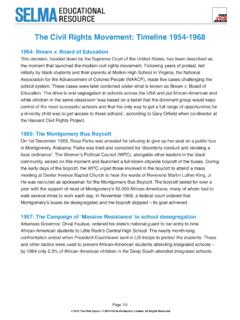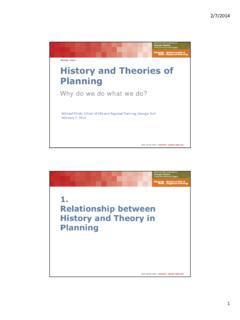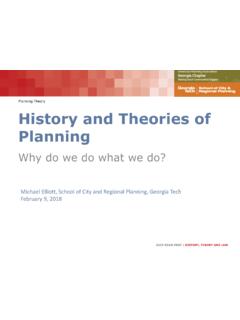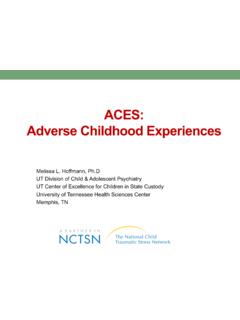Transcription of Mining Administrative Data to Spur Urban Revitalization
1 Mining Administrative Data to Spur Urban Revitalization Ben GreenHarvard UniversityCambridge, CaroCarnegie Mellon UniversityPittsburgh, Conway University of ChicagoChicago, ManducaHarvard UniversityCambridge, PlaggeUniversity of ChicagoChicago, MillerInnovation Delivery TeamMemphis, decades of Urban investment dominated by sprawland outward growth, municipal governments in the UnitedStates are responsible for the upkeep of Urban neighborhoodsthat have not received sufficient resources or maintenance inmany years. One of city governments biggest challenges isto revitalize decaying neighborhoods given only limited re-sources. In this paper, we apply data science techniquesto Administrative data to help the City of memphis , Ten-nessee improve distressed neighborhoods. We develop newmethods to efficiently identify homes in need of rehabili-tation and to predict the impacts of potential investmentson neighborhoods.
2 Our analyses allow memphis to designneighborhood-improvement strategies that generate greaterimpacts on communities. Since our work uses data that mostUS cities already collect, our models and methods are highlyportable and inexpensive to implement. We also discuss thechallenges we encountered while analyzing government dataand deploying our tools, and highlight important steps toimprove future data-driven efforts in Urban and Subject [Probability and Statistics]: Statistical computing; [Database Management]: Database Applications Data Mining , Spatial databases and GIS; [AdministrativeData Processing]: GovernmentKeywordsNeighborhood distress; Social good; Urban Revitalization This work was completed as part of the 2014 Eric andWendy Schmidt Data Science for Social Good Summer Fel-lowship at the University of Chicago, in partnership withthe City of memphis , Tennessee.
3 Previous to make digital or hard copies of all or part of this work for personal orclassroom use is granted without fee provided that copies are not made or distributedfor profit or commercial advantage and that copies bear this notice and the full citationon the first page. Copyrights for components of this work owned by others than theauthor(s) must be honored. Abstracting with credit is permitted. To copy otherwise, orrepublish, to post on servers or to redistribute to lists, requires prior specific permissionand/or a fee. Request permissions from 15,August 10-13, 2015, Sydney, NSW, is held by the owner/author(s). Publication rights licensed to 978-1-4503-3664-2/15/08 ..$ : INTRODUCTIONUS cities face a legacy of rapid outward growth and subur-banization. Since the middle of the twentieth century, mu-nicipalities across the country implemented policies designedto increase their land area, population, and tax base.
4 Ascities invested in growth, however, they neglected to prop-erly maintain their older, central neighborhoods. Popula-tions declined and the housing stock deteriorated, leavingstruggling Urban cores throughout the United efforts by governments and communities to rein-vest in central city neighborhoods have been uneven, es-pecially since the financial meltdown of 2008. While someneighborhoods have rapidly revitalized, many others con-tinue to struggle with foreclosures, crime, and neighborhoods often require more money to deliverservices than they generate back in fees and tax revenues,draining city resources. Revitalizing distressed neighbor-hoods is therefore a primary goal in many American define distress as properties in need of structural orcosmetic repairs in order to be brought up to the commu-nity s standards.
5 Although distress is perhaps more com-monly referred to as blight, we avoid that term here giventhe negative connotations associated with it. We use dis-tress to refer simply to the physical condition of homes, notas a political label assigned to is a symptom of economic malaise, but potentiallya cause as well. Distressed properties themselves producelittle or no tax revenue and send negative signals to commu-nities and investors. They can depress the value of nearbyhomes and diminish their neighborhood s quality-of-life [16,20]. Distressed and abandoned properties also limit socialinteractions among neighbors, a result linked to higher crimerates, decreased public health, and other negative indicatorsof community well-being [18].However, redeveloping traditional core neighborhoods is achallenging goal.
6 The lots and homes tend to be relativelysmall, many areas face long-standing issues with poverty andcrime, and some properties come with tax liens that raise theeffective cost to purchase the property. As a result, it oftentakes encouragement from public or nonprofit investors tokickstart private development in these policymakers must be mindful to avoid causing gen-trification or displacement, the more pressing concern inmost severely-distressed neighborhoods is improving condi-tions up to a livable data 2015 GoogleFigure 1: The land area of memphis has grown morethan 350% since 1950 due to City of memphis , TN is a case study for many ofthese issues. Over the past several decades, memphis haspursued a growth strategy of annexing land for suburban-style greenfield development. From 1950 2010, the City sgeographic area increased 350% (Figure 1).
7 Yet, in thatsame timespan, the City s population grew only 161% [3].Furthermore, memphis contains more of its regional popula-tion than many other American cities (approximately 50%,compared with 20% in Boston), meaning that it is responsi-ble for maintaining a larger portion of its sprawl [1]. This hasleft the city with a hollowing core and sprawling City s resources are, quite literally, stretched too thinacross its geography: a recent report declared memphis lit-erally does not have the financial resources to continue withthis pattern of growth [13].To combat this trend, a coalition of groups including Mem-phis government agencies and local Community Develop-ment Corporations (CDCs) have begun investing in portionsof the city s traditional Urban core. From the City s perspec-tive, rehabilitation and construction in core neighborhoodsare highly productive: they make use of existing infrastruc-ture, increase property tax revenues, and generate additionalincome from sales taxes and fees.
8 For this and other reasons,the city would like to see such renewal given the limited resources that governments and CDCshave at their disposal, they must be selective about whereto invest money. They want to find the properties and de-termine the actions that will most impact property valuesand social work described in this paper was completed in orderto aid these efforts in memphis . We worked with the Innova-tion Delivery Team, a group in the Mayor s Office funded byBloomberg Philanthropies that brings innovative approachesto pressing and complex Urban gathereddata from various government departments and neighbor-hood organizations, which we then analyzed to develop data-driven tools the City can use to improve its neighborhoodrevitalization course, Urban development cannot simply be optimizedusing data and algorithms.
9 Politics, funding, communityengagement, and individual initiative all impact what ac-tions are possible and expedient. Yet data-driven strategies2 help communities better understand which decisions willyield the most beneficial impacts. Proposing policies thatare backed by good data and analysis offers useful insightsthat can inform stakeholders throughout the planning pro-cess and increase the likelihood of focus here on three aspects of the problem: identi-fying distressed properties, characterizing their effects onneighborhoods, and assessing the costs and benefits of reme-diation strategies. We first describe previous related workand the data used for our analyses (Sections 2 & 3). Sec-tion 4 describes the tools we developed that mine neighbor-hood surveys and Administrative data to identify distressedhomes.
10 In Section 5, we discuss our efforts to evaluate theimpacts of distressed homes and different investment strate-gies on neighborhood property values. After highlightingour primary impacts in memphis in Section 6, we discuss inSection 7 important lessons learned while conducting datascience analyses for municipal governments. Finally, we dis-cuss future work in Section 8 and conclude in Section of our code and some data used in our analyses areavailable RELATED WORKMany studies have attempted to quantify the effects ofdistressed and abandoned homes on neighborhood propertyvalues. A 2001 study conducted in Philadelphia found that all else being equal, houses on blocks with abandonmentsold for $6,715 less than houses on blocks with no abandon-ment [16]. The same study also warns against demolishinghomes, finding that rehabilitating properties was more ef-fective at stabilizing of vacant homes find that these properties havefar-reaching detrimental effects on cities: they are threatsto public safety, drive down neighborhood property values,and decrease the community s quality-of-life [20].

















